Posted by: Northwest Eye in General on October 25, 2025
Overview
The article compassionately addresses the causes and treatments for green eye discharge, acknowledging the concerns many may feel when experiencing this issue. It highlights conditions such as:
- bacterial conjunctivitis
- viral conjunctivitis
- allergic conjunctivitis
- dry eye syndrome
- keratitis
- styes
as common culprits.
We understand that encountering these symptoms can be worrisome, and it’s important to recognize the significance of seeking timely medical advice. By doing so, you can prevent complications and ensure the best possible care. Evidence shows that many cases can resolve effectively with proper treatment and good hygiene practices.
We are here to help you through this process, providing the information you need to feel reassured and supported.
Introduction
Understanding the causes of green eye discharge is essential for maintaining your eye health and preventing complications. This common yet concerning symptom can arise from various conditions, including:
- Bacterial conjunctivitis
- Viral conjunctivitis
- Allergic reactions
- Sinus infections
We understand that experiencing this can be unsettling, and it’s natural to have questions about what it means for your health.
In this article, you will discover valuable insights into the underlying issues that lead to green eye discharge. We’ll explore effective treatment options and preventive measures that can help you feel more secure in managing your symptoms. However, it’s common to feel unsure about how to differentiate between harmless irritation and a more serious condition that requires medical attention. We are here to help you through this process.
Northwest Eye: Expert Diagnosis and Treatment for Green Eye Discharge
At Northwest Eye, we understand that dealing with eye issues can be concerning, particularly when it involves green eye discharge. Our dedicated team of skilled ophthalmic surgeons is here to help you navigate these challenges with compassion and expertise. With over 50 years of committed service in eye care, we utilize advanced diagnostic tools and personalized treatment strategies to effectively address the root causes of your concerns.
We believe that patient education is crucial in enhancing health outcomes. By ensuring that you understand your condition and the available treatment options, we empower you to take an active role in your eye health. It’s common to feel overwhelmed, but our approach has been shown to improve patient satisfaction and adherence, leading to more effective management of issues like green eye discharge.
Our expert team is dedicated to providing the highest quality care, ensuring that every patient receives tailored solutions that meet their unique needs. We are here to support you every step of the way, reinforcing that you are not alone in this process.
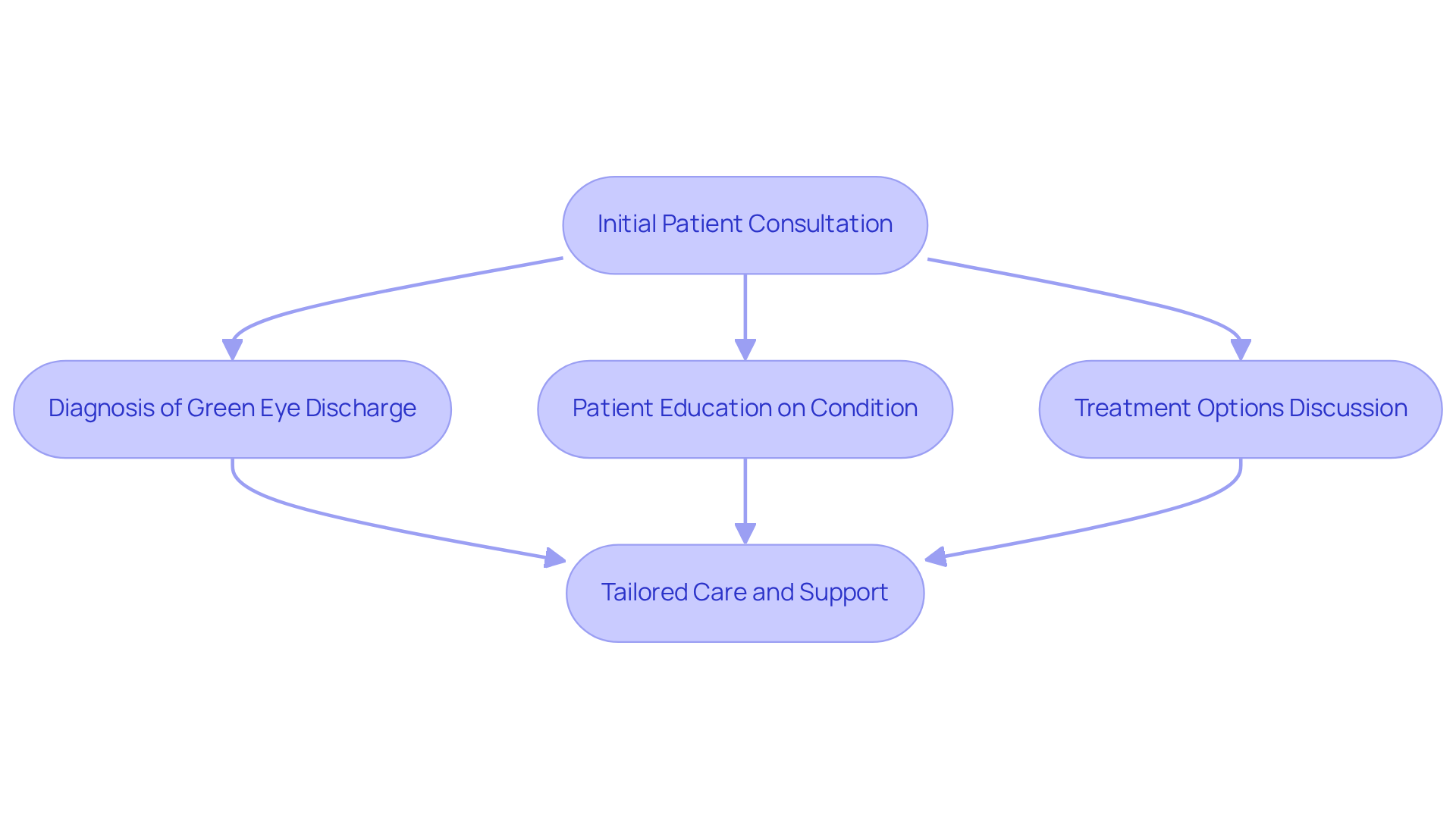
Bacterial Conjunctivitis: Symptoms and Treatment Options
Bacterial conjunctivitis can be concerning, and it’s characterized by signs such as redness, swelling, and green eye discharge. We understand that you may be worried about this condition, but recent studies show that it often resolves on its own. Approximately 65% of cases clear up without antibiotic treatment within 2-5 days. Most uncomplicated cases tend to resolve spontaneously without any adverse outcomes.
However, if antibiotics are necessary, topical eye drops or ointments are typically prescribed. Evidence indicates that antibiotics can enhance clinical recovery by 26% compared to placebo, and they are associated with a 53% higher likelihood of achieving microbiological cure. It’s essential to complete the full course of antibiotics to ensure the infection is fully resolved and to minimize the risk of recurrence.
Effective management strategies also include educating patients on hygiene practices, such as:
- Regular hand washing
- Avoiding the sharing of personal items
These practices are crucial in preventing the spread of infection. Additionally, we recommend an interprofessional team approach for optimal patient outcomes in managing bacterial conjunctivitis.
Real-life examples show that timely intervention and adherence to treatment guidelines significantly improve patient outcomes. Remember, we are here to help you through this process, and with the right care, you can feel better soon.
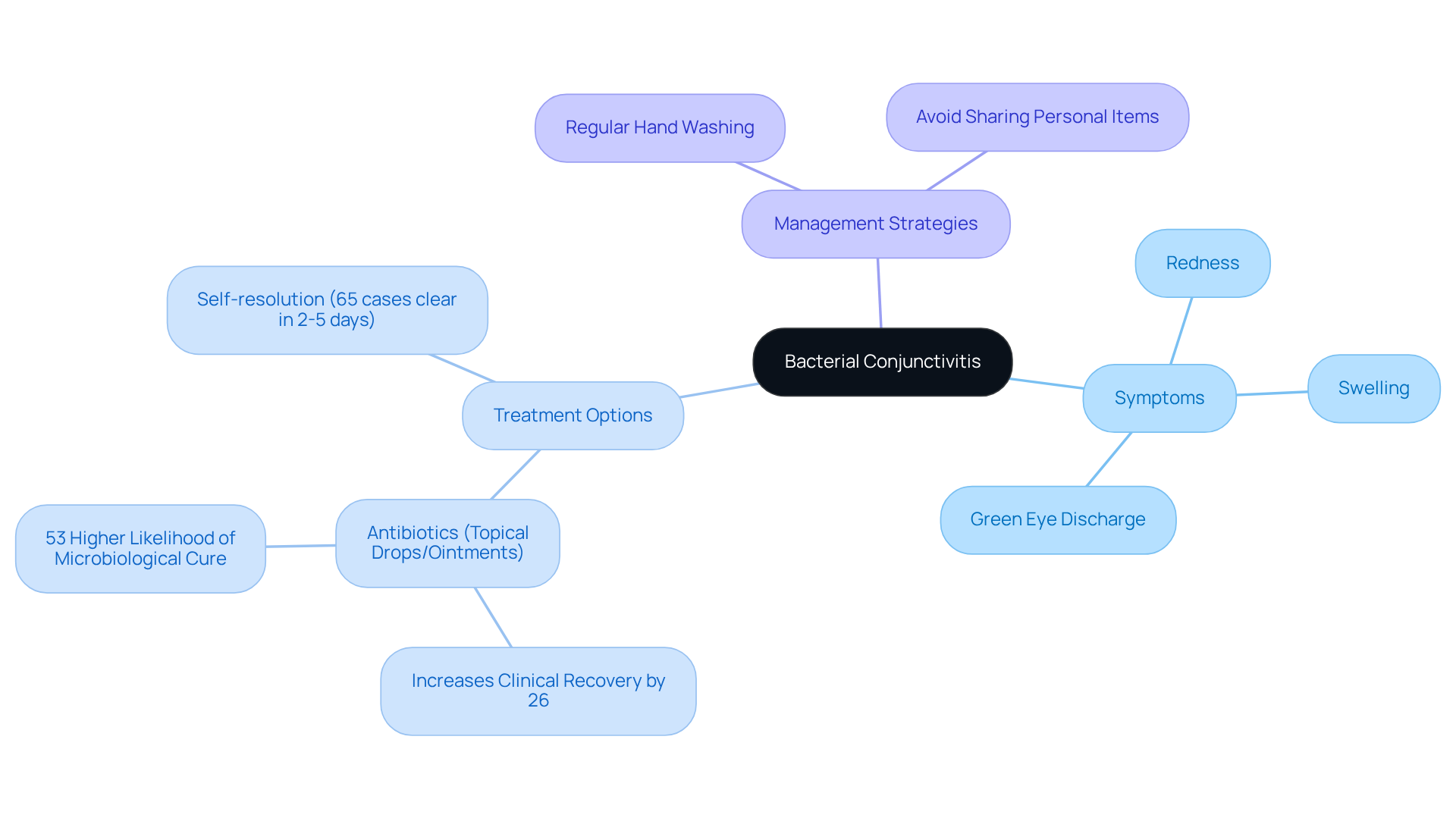
Viral Conjunctivitis: Understanding Symptoms and Management
Viral conjunctivitis can be concerning, marked by symptoms like watery fluid, redness, and itching. We understand that these signs may cause discomfort and worry. Unlike bacterial conjunctivitis, which often requires antibiotic treatment, viral conjunctivitis is typically self-limiting, meaning it usually resolves on its own within one to two weeks.
Current research shows that about 80% of viral conjunctivitis cases are caused by adenoviruses, highlighting how common and contagious this condition can be. It’s natural to feel anxious about the spread of the virus, but rest assured that management primarily focuses on providing symptomatic relief. Simple measures, such as applying cool compresses and using artificial tears, can help alleviate discomfort.
Eye care professionals emphasize the importance of hygiene practices during this time. We advise you to avoid touching your eyes and to wash your hands frequently to help prevent the virus from spreading. It’s common to feel overwhelmed, but real-world experiences show that supportive care, combined with good hygiene, can lead to effective management of viral conjunctivitis. With these practices, you can recover comfortably, often without the need for antibiotics. Remember, we are here to help you through this process.
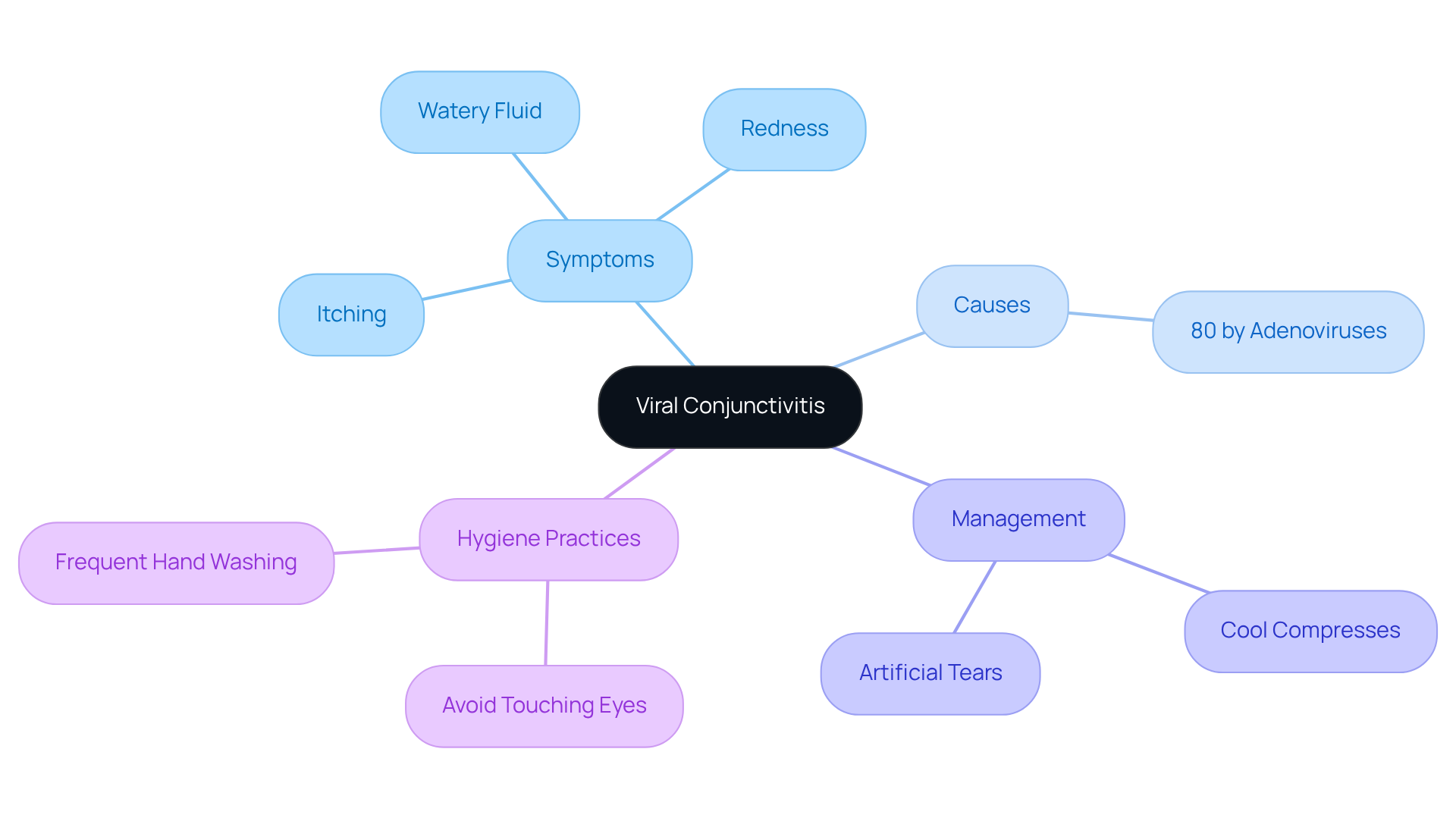
Allergic Conjunctivitis: Triggers and Prevention Strategies
We understand that dealing with allergic conjunctivitis can be challenging. Often triggered by pollen, pet dander, or dust mites, it leads to discomforting symptoms like itching, redness, and watery eyes. It’s common to feel overwhelmed by these reactions, but there are effective ways to manage them.
To help alleviate your symptoms, consider these prevention strategies:
- Avoid known allergens
- Use antihistamine eye drops
- Maintain a clean environment
We are here to help you through this process. Consulting with your healthcare provider can lead to a personalized allergy management plan that addresses your specific needs. Remember, you are not alone in this journey.
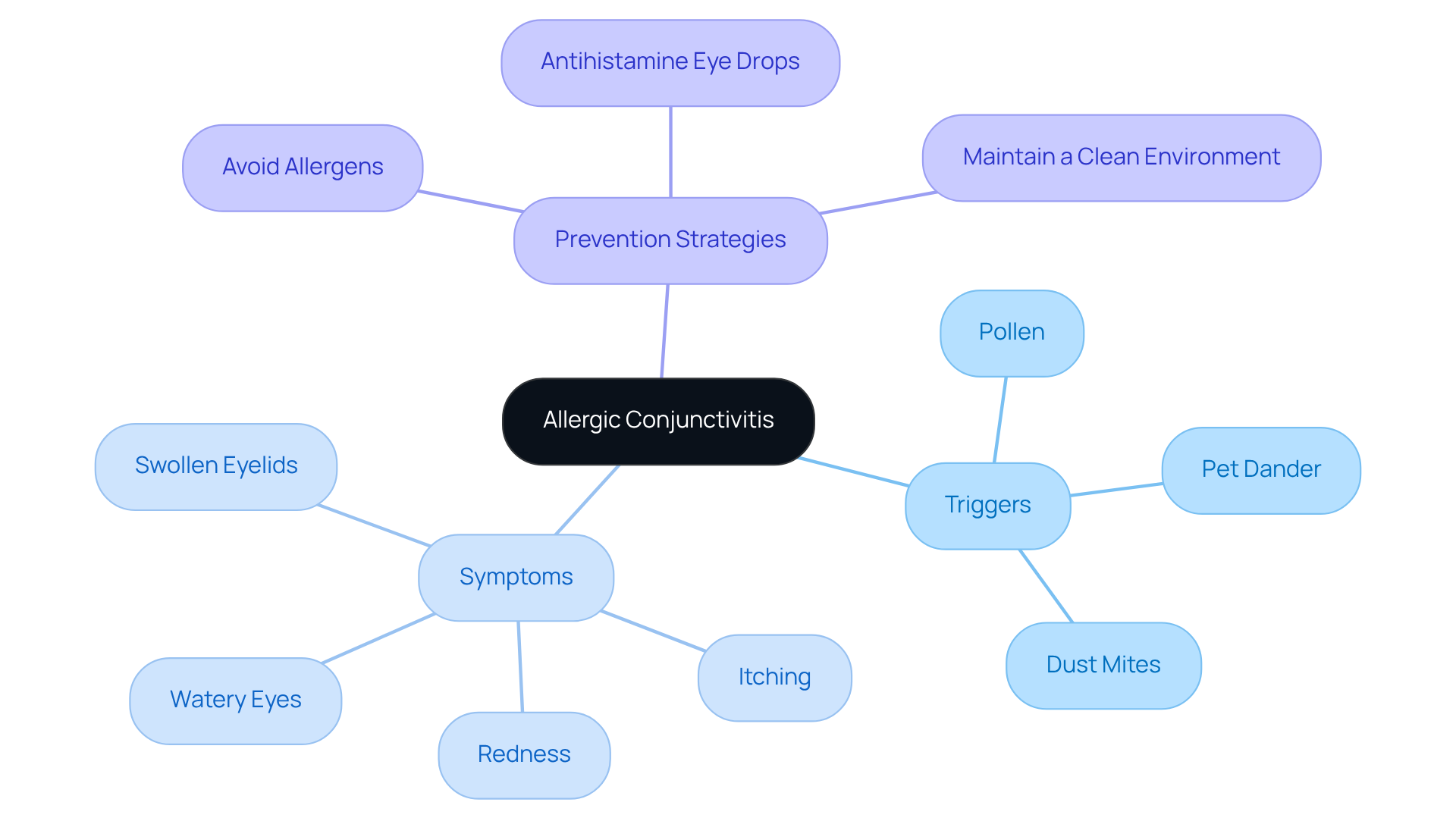
Dry Eye Syndrome: Symptoms and Treatment Approaches
Dry eye syndrome can be a frustrating experience, often presenting with ongoing dryness, irritation, and a gritty feeling. We understand that these symptoms can sometimes escalate to green eye discharge due to secondary infections, which can be concerning. This condition affects nearly 30 million Americans and over 300 million individuals worldwide. Research indicates that around 54% of patients visiting outpatient clinics exhibit symptoms of dry eye syndrome, highlighting its prevalence.
Effective management strategies can provide relief. One of the most common solutions is the use of artificial tears—there are over 50 different types available to help treat dry eye disease. Additionally, prescription medications, such as anti-inflammatory eye drops, have been shown to alleviate discomfort and improve tear production. We know that exploring these options can feel overwhelming, but you are not alone in this journey.
Lifestyle adjustments also play a crucial role in easing discomfort. For instance, increasing humidity in your living space and reducing airflow can significantly enhance moisture levels in the air, helping to mitigate dryness. It’s common to feel that small changes can make a big difference, and we encourage you to consider these adjustments as part of your self-care routine.
Regular follow-ups with an eye care professional are vital for monitoring your condition and adjusting treatment plans as necessary. Ophthalmologists stress that early identification of symptoms and the application of customized treatment approaches can lead to improved outcomes. This, in turn, enhances the quality of life for those affected by dry eye syndrome. Remember, identifying these indicators is the first step toward pursuing suitable treatment and improving your overall eye health. We are here to help you through this process.
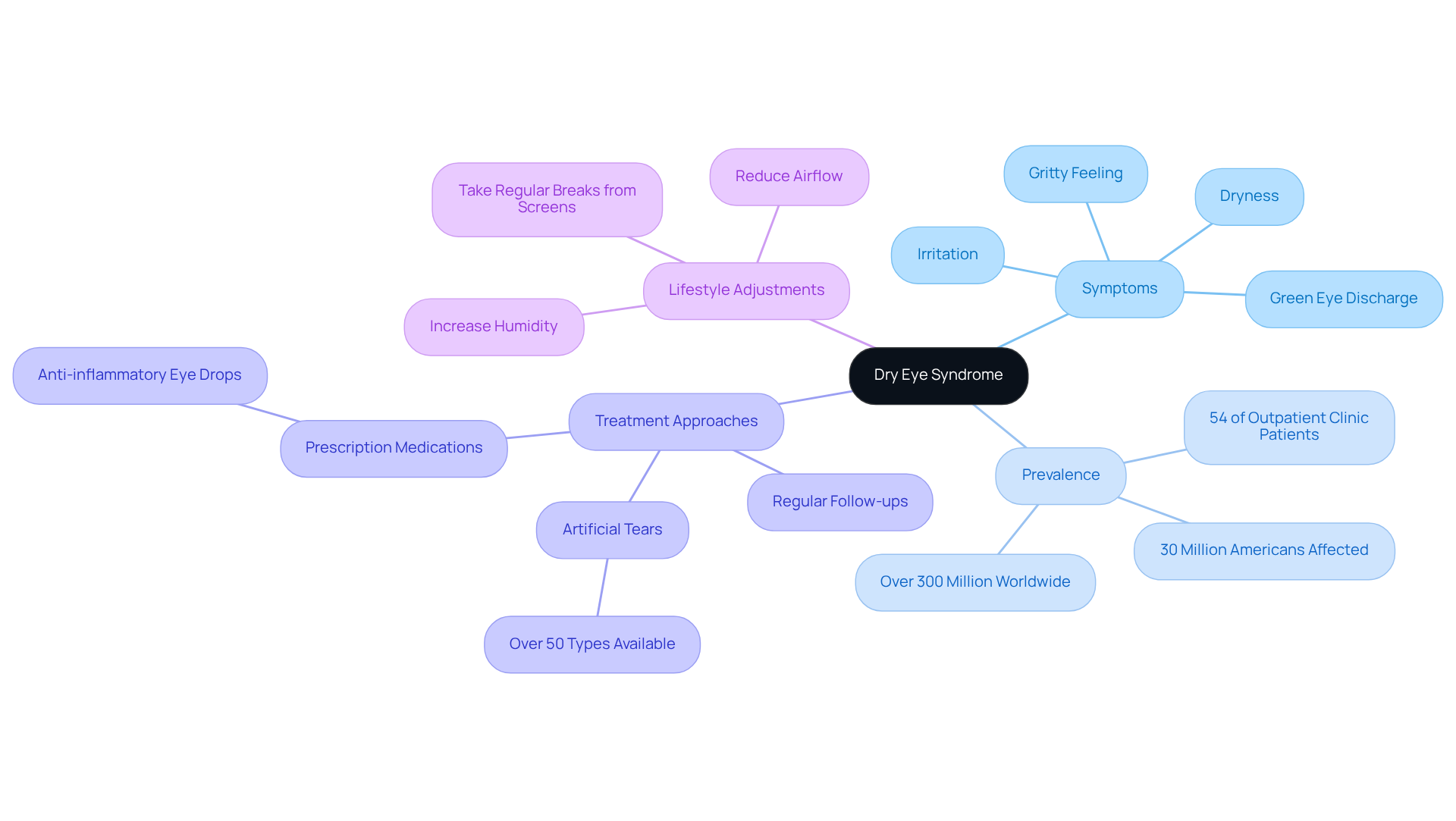
Keratitis: Symptoms and Urgency of Medical Attention
Keratitis is an inflammation of the cornea that can cause severe pain, redness, and green eye discharge. We understand that this condition can be distressing, and it can arise from various causes, including:
- Bacterial infections
- Viral infections
- Fungal infections
- Contact lens misuse
- Eye injuries
It’s important to note that improper contact lens hygiene—like wearing lenses while swimming or not cleaning them properly—significantly increases the risk of developing keratitis. In fact, bacterial keratitis often occurs in individuals who wear contact lenses, especially if they do not clean and store them properly. Studies show that bacterial infections are the most common cause of keratitis, affecting both recurrent and naïve cases.
Immediate medical attention is crucial, as untreated keratitis can lead to serious complications, including permanent vision loss. We recognize that the typical duration from the appearance of signs to the initial medical consultation can extend to 17 days, which can worsen the situation. Eye care specialists emphasize that early intervention is key; as one expert noted, “If not treated, keratitis can lead to a variety of issues, such as corneal scarring and temporary or even permanent vision loss.”
Approximately 930,000 visits to doctors’ offices and 58,000 trips to emergency departments for keratitis occur each year in the U.S. This highlights the prevalence of this issue and the importance of awareness and prompt intervention. If you are experiencing symptoms of keratitis, we encourage you to seek care promptly to prevent further deterioration of your eye health. Effective management options are available, and prompt treatment can greatly enhance outcomes. Remember, we are here to help you through this process and emphasize the importance of education about this serious eye issue.
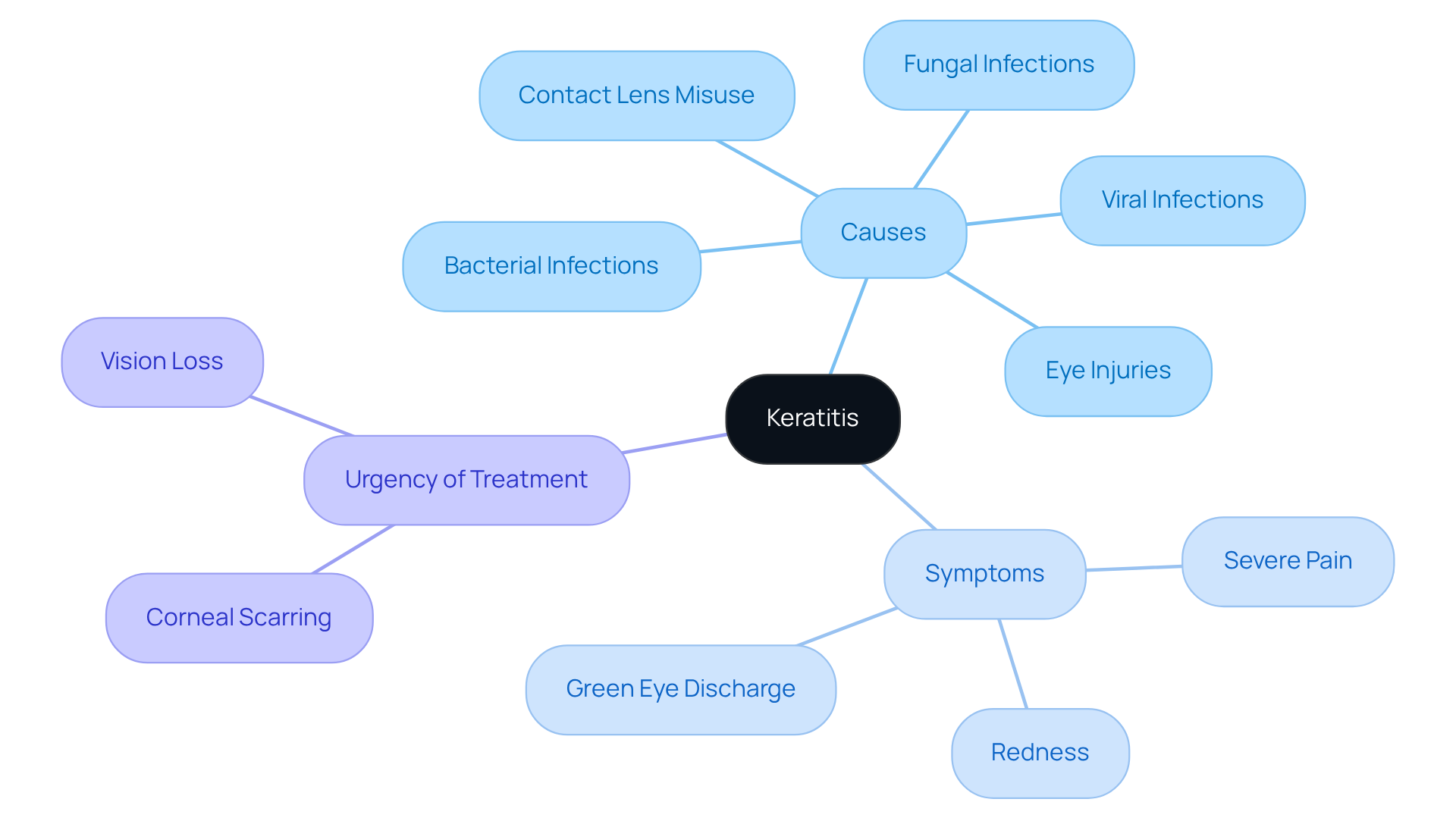
Styes: Causes and Treatment Options
Styes, or hordeola, can be painful and distressing lumps that form on the eyelid due to blocked oil glands, often resulting in redness and green eye discharge. We understand how uncomfortable this can be, and effective management begins with warm compresses. These can significantly reduce swelling and promote drainage, providing much-needed relief. We recommend applying a warm washcloth for 10 to 15 minutes, three to five times a day. This simple practice can alleviate discomfort and facilitate healing.
It’s reassuring to know that in most cases, styes resolve within one to two weeks without complications. However, if you notice that pain or swelling increases after the first two to three days, it’s wise to see your healthcare provider. Statistics show that approximately 90% of styes resolve with conservative treatment, highlighting the effectiveness of warm compresses and proper eyelid hygiene. Remember, it’s common to feel tempted to squeeze or pop a stye, but doing so can exacerbate the infection and lead to complications.
Several risk factors can contribute to the development of styes, including:
- Inadequate eyelid cleanliness
- Chronic blepharitis
- Immunosuppression
- Conditions like diabetes
We’ve seen real-world success stories where patients who regularly used warm compresses reported considerable relief from pain and swelling, often resulting in a faster resolution of their issues. Additionally, consider replacing your eye makeup every two to three months to help reduce the risk of bacterial growth, which can contribute to stye formation.
In summary, understanding the causes and effective treatment options for styes is essential for managing this common condition. By adhering to these recommended practices and seeking timely medical advice when necessary, you can achieve better outcomes and minimize discomfort. Remember, we are here to help you through this process.
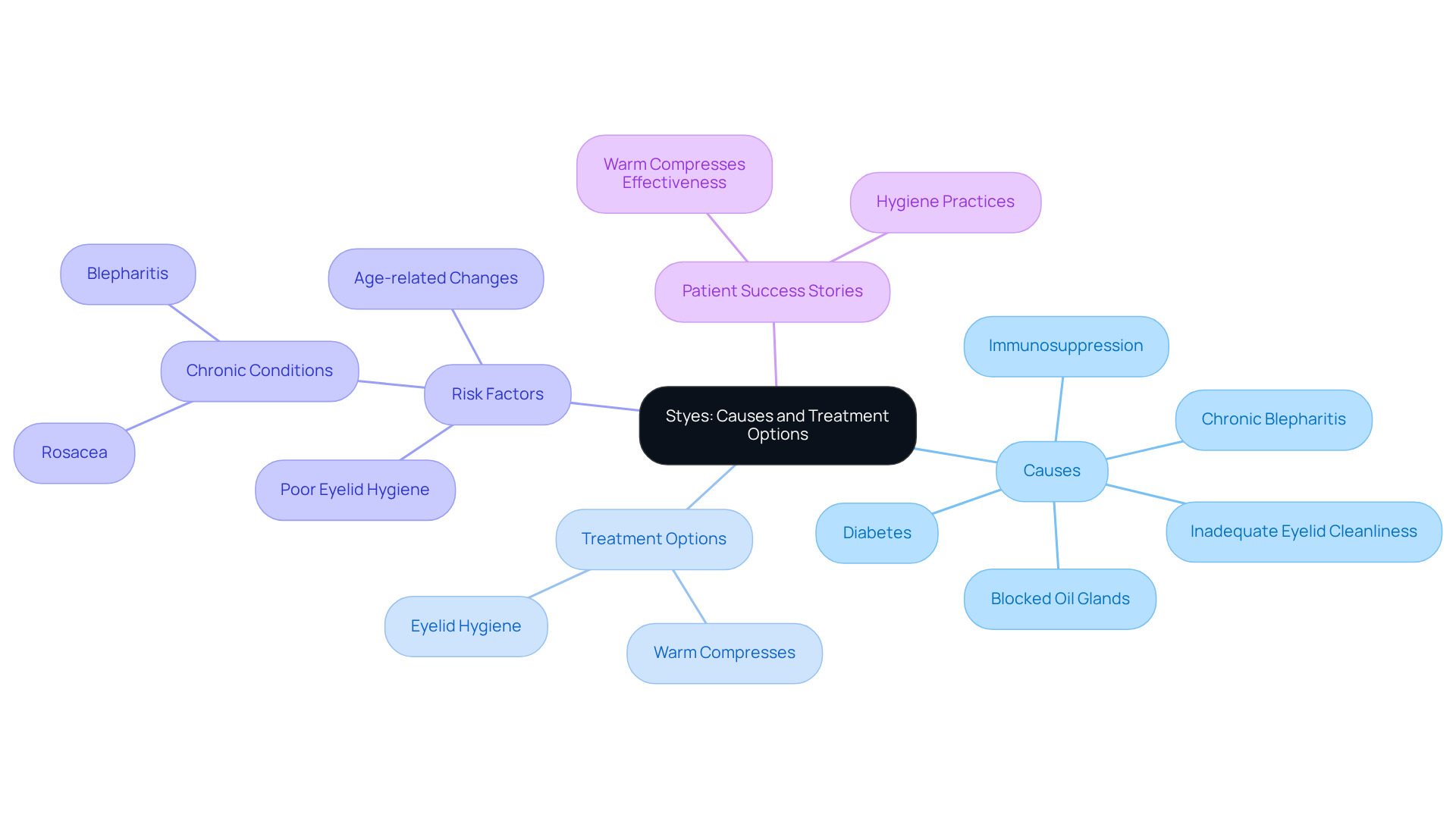
Sinus Infections: How They Contribute to Green Eye Discharge
Sinus infections often lead to inflammation and pressure within the sinuses, which can cause symptoms like nasal congestion and can also result in green eye discharge. We understand that this can be concerning, particularly due to the close anatomical connection between the sinuses and the eyes. When inflammation occurs, mucus can overflow into the eyes, leading to discomfort.
Treatment typically involves decongestants and nasal sprays to relieve congestion. If a bacterial infection is confirmed, antibiotics may be prescribed. For instance, we recall a case involving a toddler who had green fluid from both eyes and nasal mucus. This situation highlighted the importance of seeking medical assessment, which resulted in recommendations for antibiotics and appropriate eye care.
Given that sinus infections affect approximately 11.6% of adults, it is crucial for patients to consult their healthcare provider for personalized management strategies. Identifying the signs early can significantly enhance comfort and prevent complications related to unmanaged sinus infections affecting the eyes.
Furthermore, blurred vision can indicate various eye issues, and only a Northwest Eye physician or eye care expert can provide a precise diagnosis and treatment plan for any troubling symptoms. Remember, we are here to help you through this process.
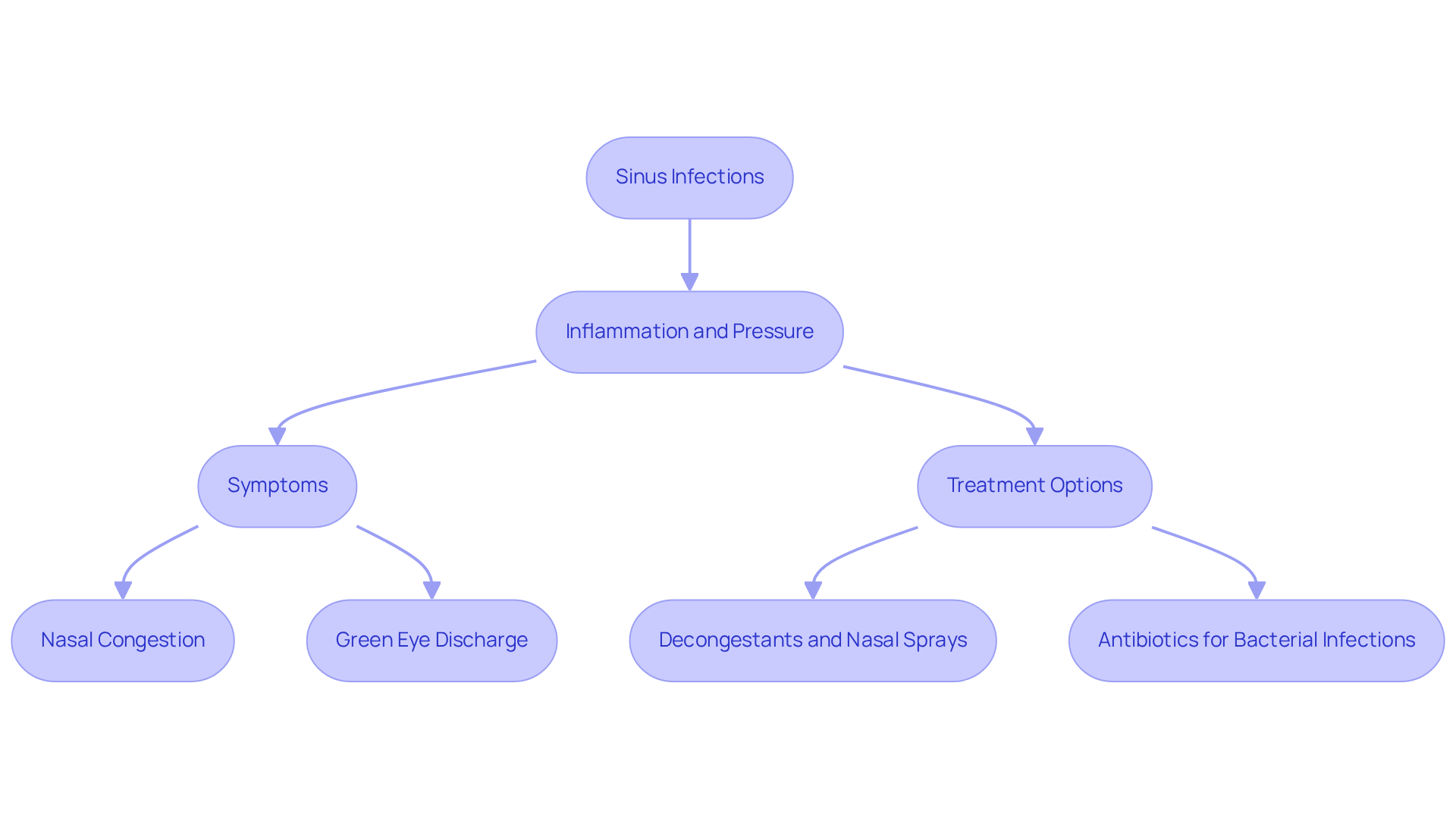
Eyelid Hygiene: Essential Tips for Prevention and Management
Maintaining good eyelid hygiene is crucial for preventing infections and effectively managing conditions that may result in green eye discharge. We understand that caring for your eyes can feel overwhelming, but here are some essential tips to ensure your eyelids remain clean and healthy:
- Gently clean the eyelids daily using warm water and a mild, non-irritating soap or a specialized eyelid cleanser. This helps remove debris and bacteria that can accumulate.
- Always cleanse your hands thoroughly before contacting your eyes to reduce the chance of introducing harmful bacteria.
- Use clean towels or disposable wipes to avoid cross-contamination. Ensure that any cloths used for cleaning are fresh and sanitized.
- Regularly replace eye makeup, particularly mascara and eyeliner, to prevent bacterial growth. Avoid sharing personal items like makeup to further reduce infection risks.
- Incorporate warm compresses into your routine; applying a warm, moist cloth to closed eyes for 5-10 minutes can help soothe irritation and improve oil flow from the meibomian glands, which are essential for tear stability.
- If you encounter ongoing issues or have inquiries regarding your eyelid care routine, please seek professional guidance. Eye care specialists stress that adequate eyelid cleanliness is a fundamental measure in preserving eye wellness and averting different ocular issues, including those that result in green eye discharge. We are here to help you through this process.

When to Seek Medical Advice for Green Eye Discharge
As a parent, it’s understandable to feel concerned when your child experiences green eye discharge. If your child experiences severe pain, noticeable changes in vision, or if issues persist despite your home care efforts, it’s important to seek medical advice. Additionally, the presence of fever or swelling around the eye requires immediate evaluation. We understand that delaying treatment can lead to serious complications, such as corneal damage or chronic infections, which may necessitate more intensive interventions.
Ophthalmologists emphasize the importance of early intervention. As one expert noted, ‘Your eyes are the lens through which you experience life; protect them with precision and care.’ Recognizing symptoms such as green eye discharge and acting promptly can significantly improve outcomes and ensure appropriate treatment. Remember, we are here to help you through this process, and your child’s well-being is our priority.

Conclusion
Understanding the causes and treatments for green eye discharge is essential for maintaining your eye health and addressing any underlying conditions. We recognize that this can be a concerning issue. This article highlights various factors contributing to this common problem, ranging from bacterial and viral conjunctivitis to dry eye syndrome and keratitis. Each condition presents unique symptoms and management strategies, emphasizing the importance of recognizing signs early and seeking appropriate care.
Key insights include:
- The effectiveness of antibiotics for bacterial conjunctivitis.
- The self-limiting nature of viral conjunctivitis.
- The need for proper eyelid hygiene to prevent infections.
It’s also important to note that conditions like allergic conjunctivitis and sinus infections can lead to green eye discharge, underscoring the interconnectedness of eye health and overall well-being.
Ultimately, proactive engagement in your eye care, including regular consultations with eye care professionals and adherence to hygiene practices, can significantly improve your outcomes. By understanding the nuances of these conditions and their treatments, you can take informed steps toward better eye health and seek timely medical advice when necessary. Remember, prioritizing your eye care today can lead to a healthier tomorrow. We are here to help you through this process.
Frequently Asked Questions
What is green eye discharge and why is it a concern?
Green eye discharge can be a sign of eye issues, particularly bacterial conjunctivitis. It is characterized by redness, swelling, and discharge, which can be concerning for individuals experiencing these symptoms.
How does Northwest Eye approach the treatment of green eye discharge?
Northwest Eye employs a dedicated team of skilled ophthalmic surgeons who use advanced diagnostic tools and personalized treatment strategies to address the root causes of eye concerns, including green eye discharge.
What is bacterial conjunctivitis and what are its symptoms?
Bacterial conjunctivitis is an eye condition marked by redness, swelling, and green eye discharge. It is often concerning but can resolve on its own in many cases.
How effective is antibiotic treatment for bacterial conjunctivitis?
Antibiotics can enhance clinical recovery by 26% compared to placebo and are associated with a 53% higher likelihood of achieving microbiological cure. However, approximately 65% of cases resolve without antibiotics within 2-5 days.
What hygiene practices are recommended to prevent bacterial conjunctivitis?
Recommended hygiene practices include regular hand washing and avoiding the sharing of personal items to prevent the spread of infection.
What are the symptoms of viral conjunctivitis?
Viral conjunctivitis is characterized by symptoms such as watery fluid, redness, and itching.
How is viral conjunctivitis treated?
Viral conjunctivitis is typically self-limiting and usually resolves on its own within one to two weeks. Management focuses on providing symptomatic relief through measures like cool compresses and artificial tears.
What precautions should be taken during viral conjunctivitis?
It is important to avoid touching the eyes and to wash hands frequently to prevent the virus from spreading during an episode of viral conjunctivitis.
How does Northwest Eye support patients dealing with eye issues?
Northwest Eye emphasizes patient education to enhance health outcomes, empowering individuals to understand their conditions and treatment options while providing compassionate care throughout the process.






